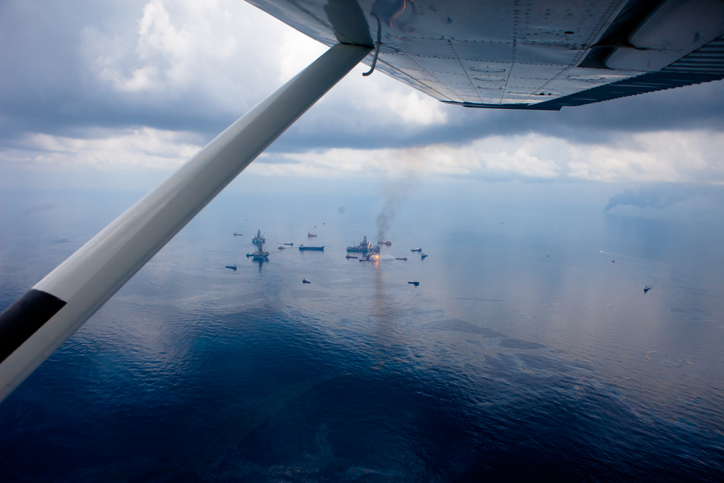On April 13, the Japanese government announced that a plan to release more than one million tonnes of contaminated water from the destroyed Fukushima nuclear plant into the Pacific Ocean had been approved. According to Tokyo, the work to release water will begin in two years.
However, this is not the only case of severe man-made ocean pollution in history. From the Exxon Valdez oil spill in 1989 to the Japanese ship oil spill in Mauritius in 2020, man-made ocean pollution is not a new phenomenon.

An aerial shot of a plane over the Exxon Valdez oil spill in Prince William Sound, Alaska, USA/Getty
An aerial shot of a plane over the Exxon Valdez oil spill in Prince William Sound, Alaska, USA/Getty
Exxon Valdez oil spill
On March 24, 1989, the Exxon Valdez, an oil tanker owned by the Exxon Shipping Company, struck the Prince William Sound reef in Alaska and spilled about 37,000 tonnes of crude oil into the water over the next few days. It was considered one of the worst oil spills ever in terms of oceanic environment pollution, as it directly caused the death of a massive amount of fish and other marine animals and ruined the local fishing industry, which was the primary income earner for residents along the coastline.
The Exxon Shipping Company spent almost $2 billion to clean up the oil spill. However, based on the National Oceanic and Atmospheric Administration's (NOAA) 2007 report, some toxic materials from the oil spill still remained in the area.

An aerial view of the BP Deepwater Horizon oil rig from a seaplane window./Getty
An aerial view of the BP Deepwater Horizon oil rig from a seaplane window./Getty
Deepwater Horizon oil spill
The Deepwater Horizon oil spill happened on April 20, 2010, in the Gulf of Mexico, when the oil drilling rig Deepwater Horizon exploded, killing 11 workers and releasing about 780,000 cubic meters of oil into the sea.
The oil covered at least 2,500 square meters of sea and affected many protected beaches and wetlands, which were home to many species. According to the November 2010 report released by the U.S. government, the oil polluted a large area of water, seriously affecting local marine animals, including fish, birds, sea turtles and dolphins. It also affected local tourism and the fishing industry.
Barack Obama, the president of the U.S. at that time, described the disaster as "the worst environmental disaster in U.S. history" and compared it with the 2001 terror attacks.

The grounded Japanese ship MV Wakashio in Mauritius. /CFP
The grounded Japanese ship MV Wakashio in Mauritius. /CFP
Mauritius oil spill
On July 25, 2020, a Japanese-owned ship named the MV Wakashio ran aground on a coral reef in Mauritius, and up to 2,000 tonnes of fuel leaked from the ship.
Mauritius is famous for its beautiful beaches and biodiversity. According to a UN report, the disaster severely damaged the local environment and its $1.6 million tourism industry.
The oil spill reportedly affected a marine park and two internationally protected wetland sites, and it might take decades to restore the sensitive ecological system.
Similar to the oil spills, the situation in Japan also started from an accident. However, in this case, the Japanese government is choosing to pollute the ocean.
After the announcement was released, the local fishing industry, residents and international environmental organizations have slammed the decision.
As the wastewater will be carried by the currents and affect other regions, countries, including China and South Korea, have raised concerns about the ocean environment.
(Cover via VCG)
(If you want to contribute and have specific expertise, please contact us at nature@cgtn.com)

